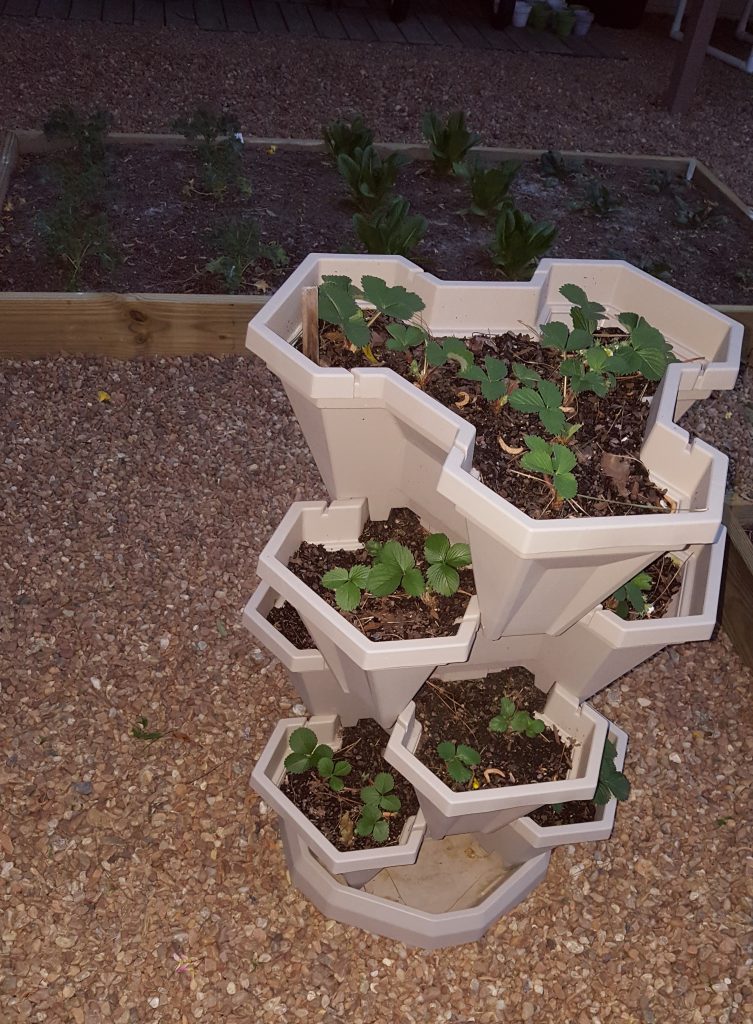Once you master how to grow strawberries in pots, you will grow them forever. It’s that addictive. And with good reason.
For one, nothing compares to the flavorful, juicy, fill-the-mouth taste that these delicacies are packed with.
Strawberries are also rich in fiber, vitamin C, and other powerful antioxidants believed to benefit heart health and help manage blood sugar.
The best part is that they aren’t fussy about soil or climate, which makes them easy to grow and care for—whether in pots or in-ground—as long as they get adequate sunlight.
Literally, all strawberries will fruit just as well in pots as with in-ground growing, only that you have to employ a few tricks to boost your chances of a successful harvest.
Ensure you choose the right strawberry variety, pot, and quality soil. The rest is simple cultivation practices, as we’ll see later in this post.
Table of contents
- FAQs on Growing Strawberry Plants in Pots for Your Container Garden🍓
- How to Grow Strawberries in Pots (from crowns or transplants)
- Winter Care for Your Potted Strawberry Plants
- Best Strawberry Varieties for Pots (or Containers)
- How to Grow Strawberries in Pots from Seeds
- The Takeaway: Once You Learn How to Grow Strawberries in Pots, It Becomes Obsessive (in a good way!)
FAQs on Growing Strawberry Plants in Pots for Your Container Garden🍓
Before you read how to plant these juicy sweet berries in pots, it might be worth your time to review some of the frequently asked questions across the internet on the topic.
What is the best container for growing strawberries?
Terracotta pots, hanging baskets, and special strawberry planters will offer your berries the comfort they need; however, for a more natural rustic effect, try willow window boxes or recycle an old vegetable/wooden wine crate.
Repurposed wheelbarrows and animal drinking troughs are also great options. Remember that whatever you opt for caters to the plants’ drainage needs.
What are the benefits of growing strawberries in containers?
There are numerous unique benefits to growing your berries in containers, including:
- Ease of plant movement to track the sun for additional light and warmth than they might otherwise get.
- Plants can be elevated to escape the interest of slugs and avoid soil-borne diseases.
- It’s also possible to force an extra crop by sheltering the plants—either under the cover of a polytunnel or greenhouse—during winter.
What is the best soil for strawberry plants?
- Though tolerant of different soil types, strawberries do best in loose, loamy soils with a slightly acidic to neutral pH level (5.5-7.0).
- A simple home soil test can help determine if your soil falls within this range.
- All you need is vinegar/baking soda and water.

How to Grow Strawberries in Pots (from crowns or transplants)
You can start your strawberries from seed, transplants, or bare-root crowns. Depending on the propagation method you choose, ensure the timing is right.
For cold-stored bare-root runners, late spring through early summer works best.
Exposed from the cold and won over, they’ll get away quite fast to fruit.
Ideally, some transplants or pot-sold strawberries should fruit the same summer. When you purchase your bare roots, check the label–the growth cycle depends on the variant.
1 – Fill the pot with potting soil
- Top up your pot of multipurpose potting soil with compost, leaving an inch of space from the rim.
- If using a premium potting mix, then you do not need compost. That’s because the compost top-up as it comes enriched with all the additives your plants need for the establishment process.
- However, the best compost for strawberries in pots is always matured homemade compost.
- If you don’t have compost at home, buy the organic version from your local garden center or large hardware stores.
2 – Add the strawberry plants
- Create a tiny mound on the surface and spread the plant’s roots over the mound.
- Cover the roots with potting soil up to the crown, then gently tamp the plant into the soil.
- Water generously so the compost settles around the roots.
- If growing more than one plant in the same pot, space them ten to twelve inches apart to allow enough room to spread.
- Add extra potting soil as needed once the soil settles after watering, making sure to not cover the crown.
3 – Add some sunshine ☀️
- Move the container to a sunny spot, where the plant receives eight to twelve hours of sunlight daily. This will help boost the blooming and fruiting process.
4 – Water and fertilize the strawberries as they grow
- Water the berries regularly whenever the top inch of the soil feels dry. As you water, take care not to wet the leaves as that may encourage the spread of fungal disease to the fruits.
- If you can, gently lift the leaves to irrigate your sunken pots.
- Fertilize regularly with a high-quality, organic liquid fertilizer once the first flowers appear. You can even use the brands promoted for tomato plant feeding. They work just as well for this purpose.
- Are your containers outside? To keep birds and rodents off the fruits, consider netting or fencing.
- Lay out straw or wood chips underneath the fruits to help keep them clean of compost.
- Cut back the foliage (except for the central young leaves) with hand shears once fruiting is over.
- Unless you intend to propagate new plants, remove the runners so the plants thicken up again before winter.
Winter Care for Your Potted Strawberry Plants
Wondering what to do with strawberry plants in pots at the end of the season? You don’t want to dispose of them, of course.
- Although they produce best when accorded a dormancy period in winter, strawberry roots can easily suffer freeze, especially in colder climates.
- Move them under a deck or into an unheated garage for winter protection. Alternatively, a polytunnel or a greenhouse will also do the job.
- Only water when the soil feels excessively dry, and do not water any foliage that might remain.
- Apply mulch in and around the container to help with insulation.
Best Strawberry Varieties for Pots (or Containers)
| Name | Type | Fruiting Time | Fruit Description | Propagates Via | Hardiness Zone |
| Fresca | Common garden strawberry (ever-bearing/day-neutral) | Mid-summer to the first frost | Medium-sized regular fruit | Runners, seeds, or dividing mature plants | 4-8 |
| Yellow Wonder | Wild/woodland strawberry (ever-bearing) | Mid-summer to the first frost | Small, sweet, pale yellow gourmet strawberries | Dividing mature plants or seeds | 6-8 |
| Mignonette | Wild/alpine/woodland strawberry (ever-bearing) | Mid-summer to the first frost | Small round fruit | Seeds or division of mature plants | 4-9 |
| Alexandria | Woodland strawberry | Mid-summer to the first frost | Small elongated fruit | Dividing mature plants or seeds | 6-8 |
| Albion | Common garden strawberry (ever-bearing/day-neutral) | Mid-summer to the first frost | Large regular fruit | Runners | 4-8 |
How to Grow Strawberries in Pots from Seeds
The best time to start your strawberries from seed is in December.
You grow strawberries from seed with a process called cold stratification, placing the seeds in a zipper top bag in your freezer. That “forced winter” tricks the seeds into deep dormancy. Removing them from the freezer sends the message to the little seeds that spring is here (even when it’s not) so they can “wake up” and begin their growth cycle.
Here’s how to do it.
- Before planting, allow the seeds a chilling period of three or four weeks by placing them into the freezer. This helps boost germination.
- Once chilled, remove the seeds from the freezer; bring them to room temperature.
- In a seed starter tray with moist potting mix, thinly sow the seeds and cover lightly with the growing mix.
- Strawberries require light to germinate, so locate the trays under grow lights.
- It may take seven days to six weeks for the seeds to sprout.
- Throughout this period, ensure the trays stay in temperatures between 65° and 75° F, and keep the seeds consistently moist, providing adequate ventilation to prevent dampening off.
- Once the seeds sprout and begin upward growth, adjust the grow lights to approximately two inches above the plants—not too high above the seedlings as it may lead to thin, leggy plants.
- Transplant into larger containers after the seedlings develop three or four sets of true leaves.
- Gradually harden off the plants before transitioning them fully into the outdoor containers.
- Ensure regular care, as discussed above, for more vigorous, healthier, and productive plants.

Related links:
The Takeaway: Once You Learn How to Grow Strawberries in Pots, It Becomes Obsessive (in a good way!)
So now you know how to grow strawberries in pots. Give other fruits a try, too. Like dragonfruit – learn how here. Let the fun part begin! Get those hands dirty. Simply, plant, irrigate, feed, and enjoy the fresh, filling aroma of your home-grown strawberries.


